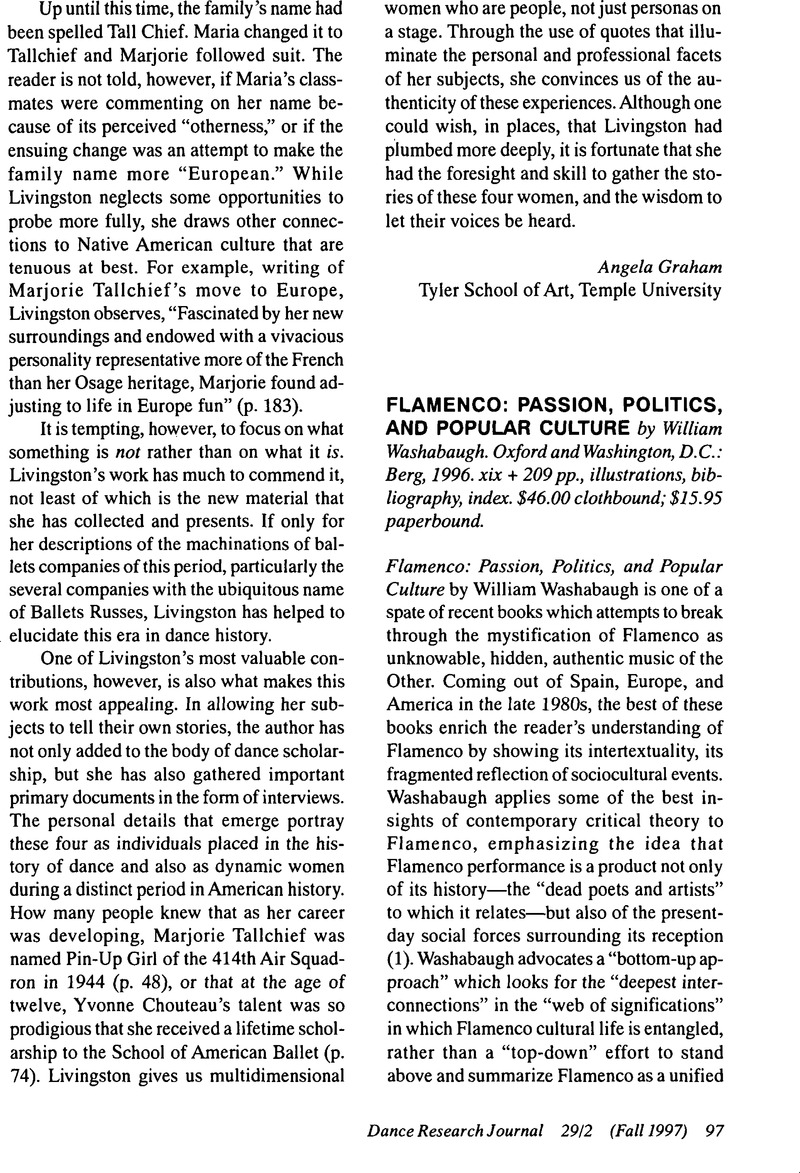No CrossRef data available.
Article contents
Flamenco: Passion, Politics, and Popular Culture, by William Washabaugh. Oxfordand Washington, D.C.: Berg, 1996. xix + 209 pp., illustrations, bibliography, index. $46.00 clothbound; $15.95 paperbound.
Published online by Cambridge University Press: 22 July 2014
Abstract

- Type
- Reviews
- Information
- Copyright
- Copyright © Congress on Research in Dance 1997
References
NOTES
1. Eliot, T. S., quoted in Shusterman, Richard, T. S. Eliot and the Philosophy of Criticism (New York: Columbia University Press, 1988): 60.Google Scholar
2. A nearly complete copy of this series was acquired and probably saved from destruction in 1988 by Columbia University through the arduous persistence of Brook Zern. The Ethnomusicology Division of the Music Department there houses one copy; there is another at the Centro Andaluz de Flamenco in Jerez de la Frontera and a third at the Golda Meir Library at the University of Wisconsin-Milwaukee. The series has just recently become commercially available.
3. For an exploration of some of these behaviors, see Weinzweig, Meira, “Carmen Amaya Wore Pants: Flamenco as a Forum for Cross-Gender Identification Within Spanish Gypsy Culture,” in 1987 Conference Proceedings, ed. Abrahams, Ruth (New York: Congress on Research in Dance, 1989): 202–208.Google Scholar
4. See, for examples, Avila, Luis Suarez, “El Romancero de los Gitanos Bajoandaluces: Del romancero a las tonás” [“The Ballad Repertoire of the Gitanos of Lower Andalucia: From the Ballad to the Tonás”], Dos Sighs de Flamenco: Actas de la Conferencia Internacional, Jerez, 21–25 Junio 1988 (Jerez de la Frontera: Fundacion Andaluza de Flamenco, 1989): 29–94Google Scholar; Sutherland, Anne, “Gypsy Women, Gypsy Men: Paradoxes and Cultural Resources,” Papers From the Sixth and Seventh Annual Meetings, ed. Grumet, Joanne (New York: Gypsy Lore Society, North American Chapter, 1986): 104–114Google Scholar; Weinzweig, Meira, “Amaya, La Fernanda, and the Hidden Matriarchy,” unpublished paper available upon request from LaMeira@Juno.com.Google Scholar
5. Mitchell, Timothy, Flamenco Deep Song (New Haven: Yale University Press, 1994): 3–4.Google Scholar
6. As Washabaugh points out, “[s]ome of the most remarkable works in this line have portrayed cante Gitano [Gypsy Song] as a tour de force of musical commercialization or, in straighter talk, a fraud. Many go so far as to suggest that the term ‘Gitano’ refers to nothing of substance, being itself part of the process of commercial invention. For example, García Gómez (1993), Gelardo and Belade (1985), Mercado (1982), Mitchell (1994), and Steingress (1993) all contend that the social category of Gitano is vague, indistinct from the Andalusian lumpen, and trumped up with attractive features and positive values so as to make a killing on the flamenco music circuit” (p. 73).
7. See Molina, Ricardo and Mairena, Antonio, Mundo y Formas del Cante Flamenco (Sevilla: Librería Al-Andalús, 1963).Google Scholar
8. I am indebted to Gottschild's, Brenda DixonDigging the Africanist Presence in American Performance: Dance and Other Contexts (Westport, Connecticut: Greenwood Press, 1996)Google Scholar for the use of this term.
9. Mitchell, pp. 47, 129, 215. Mitchell lets Prosper Mérimée assert for him that “the chastity of Spain's gitanas” was “greatly exaggerated,” and that “far from their purity, it was their repulsive lack of hygiene that kept suitors at bay” (p. 58). Strange that such filthy and ugly women could have been so fascinating and alluring to so many men, among them Mérimée himself, who created the archetypical Carmen. One wonders whether Mitchell, like Mérimée, protests too much.
10. Gottschild, p. 4.1 have extrapolated Gottschild's paradigm of black/white America to the Flamenco context.
I would like to thank Clara Mora Chinoy for reading this review and offering many helpful comments.


